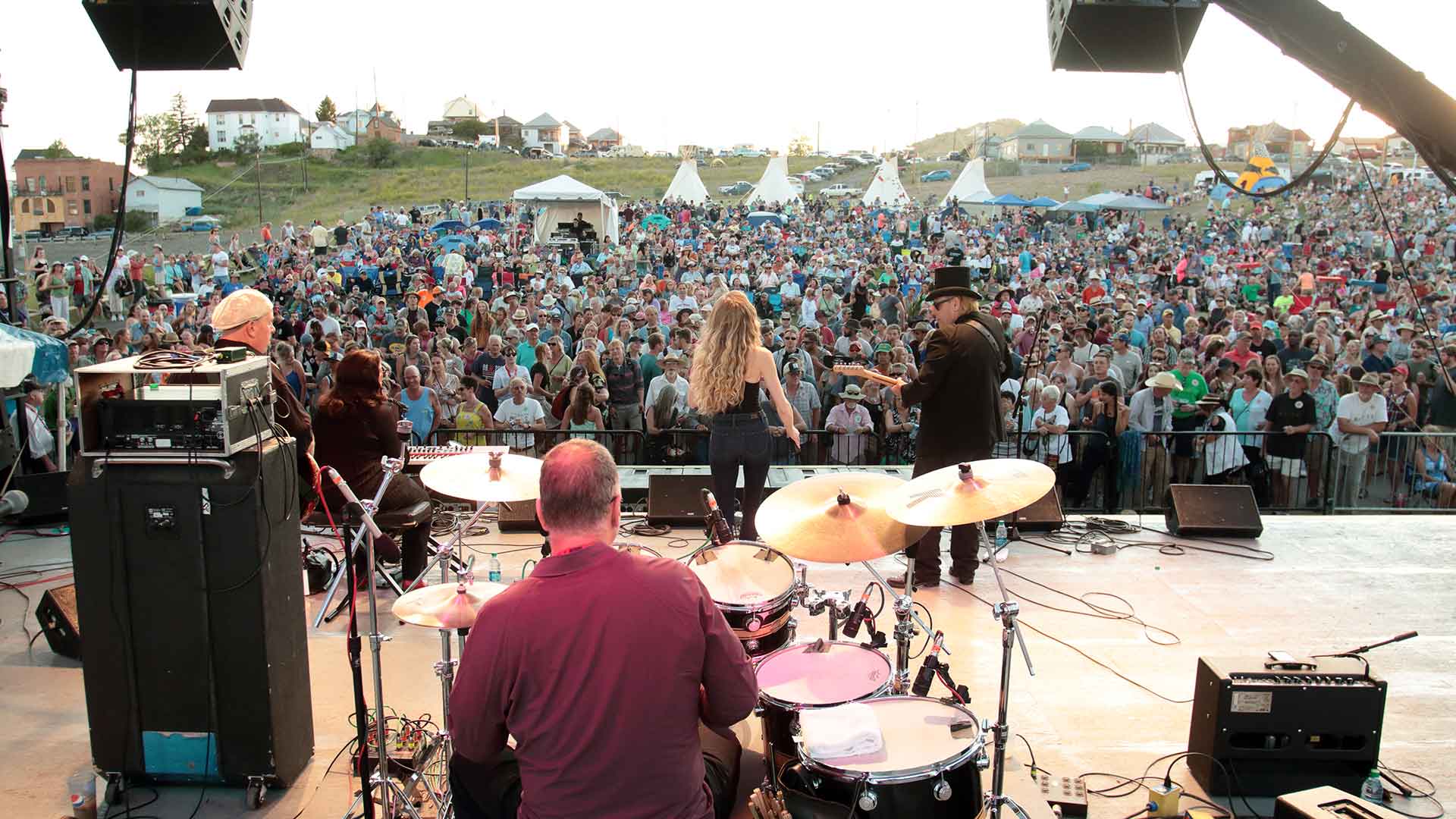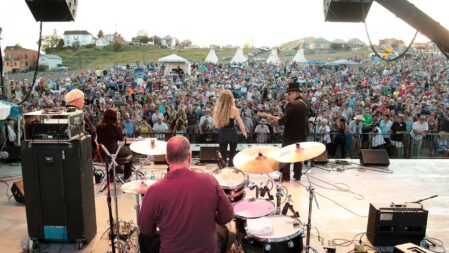The Montana Folk Festival is one of the Northwest’s Largest FREE Outdoor Music Festivals.
The Montana Folk Festival features performances and demonstrations by over 200 of the nation’s finest musicians, dancers, and craftspeople. It showcases multiple performances by more than 20 Artists/groups on six stages including a dance pavilion dedicated to participatory dancing, a family stage with performances appealing to children of all ages, and a Montana folklife stage. In addition to the performance stages, there are several themed festival areas: the Montana Folklife Area, the Family Area, two Festival Marketplaces and the Festival Food Courts.
The festival site is situated in the heart of the nation’s largest National Historic Landmark District. Open-air and tented sites will provide a variety of performance venues ranging from intimate stages to amphitheater-sized venues. The Original Stage, which offers a panoramic view of Butte’s historic high rise buildings and the surrounding mountains, is located on the site of the historic Original Mineyard, with its dramatic headframe that is a remnant of Butte’s early days as an underground copper mining center.
| Festival dates: | 2nd Full Weekend Of July |
| Hours of operation: | Friday – Sunday |
| Schedule of performances: | See Schedule |
Festival Marketplaces.
Up to 50 traditional artists and craft vendors will be hosted in the festival’s two marketplaces: the Montana Traditions Arts Market and the nearby First Peoples’ Market that will feature Native American artists and craftspeople.
Food and Drink Vendors.
Nearly 30 food and beverage vendors will serve ethnic and festival food representing the cuisine of natives and immigrants to the region as well as festival favorites such as kettle korn, funnel cakes, fresh-squeezed lemonade and huckleberry shakes.
Free to All.
Admission throughout the three-day event is free of admission to everyone.
Festival Music Sales.
Throughout the festival, there will be opportunities to purchase the recorded music of the performing artists who will also be available to sign CDs after their performances near the CD sales tents.
Festival Merchandise.
At assigned booths, festival-goers can purchase festival merchandise, too, including shirts, hoodies, hats and other commemorative merchandise.
Information Booths.
Strategically placed booths will be available for directions and answers to all questions. Try to stump the volunteers with questions you can think of about the festival, the community of Butte and where to go and what to see in the state of Montana.
Beer and Wine Sales.
Beer and wine will be available for sale at special booths and imbibing areas.
Volunteer Registration.
Volunteers who sign up in advance can check-in at the volunteer registration booth to get their assignments and their T-shirts. We still need help (only 900 or so are needed) to help complete a variety of tasks to help put up, operate and then tear down such a large festival site.
From National to Regional, The History of The Montana Folk Festival speaks for itself.

The Montana Folk Festival is the successor event to the National Folk Festival that was presented in Butte from 2008 to 2010. First presented in St. Louis in 1934, the National is the oldest, longest-running and most diverse festival of traditional arts in the nation. Championed in its early years by Eleanor Roosevelt, it was the first event of national stature to put the arts of many nations, races, and languages into the same event on an equal footing.
Some of the artists presented at the first festival are now legendary. W.C. Handy’s first performance on a desegregated stage was at the 1938 National. It was the first national event to present the blues, Cajun music, a polka band, a Tex-Mex conjunto, a Sacred Harp ensemble, or a Peking opera. More information about the history of the National is available from the non-profit organization that has organized the event since 1934 — the National Council for the Traditional Arts (NCTA).
Montana had the honor of presenting the National during its 70th – 72nd presentations in Butte in partnership with the NCTA. Over the three
Based on tourist surveys, the admission-free outdoor festival brought more than $20 million in earnings for businesses in communities throughout the state in 2009. The economic impact in the third year was about $31 million, with an estimated 165,000 visitors to the event.
No small wonder that after three years as the host for the National Folk Festival, Montana organizers declined to fold up the tents for good.
When the National Folk Festival moved on, Montana organizers decided to apply what they had learned to carry the traditions forward with a new event that offers much more for years to come — the Montana Folk Festival. Since before the first note played on the first of three successful Nationals, the goal has been to develop a successor festival that exceeds the expectations and excitement of the three National festivals that went before at the same time that economies of scale are achieved to make the festival a sustainable event for long into the future.
As the festival has made the transition in 2011 to the Montana Folk Festival, the economic impact has continued at about $25 million a year throughout the region.
As it has since 2011, the tradition of the Montana Folk Festival will continue.
For answers to questions about the event’s history or on any other aspect of the festival, please contact us.
About Montana and Butte.
Butte is Montana’s Festival City. Located between Yellowstone and Glacier National Parks at the crossroads of two major Interstate highways, I-15 and I-90, the Montana Folk Festival will join Butte’s festival season that begins early in February with the world’s loudest and shortest Chinese New Year’s Parade followed by one of the nation’s most famous St. Patrick’s Day celebrations in March, and the Montana Irish Festival on the second full weekend of August.


